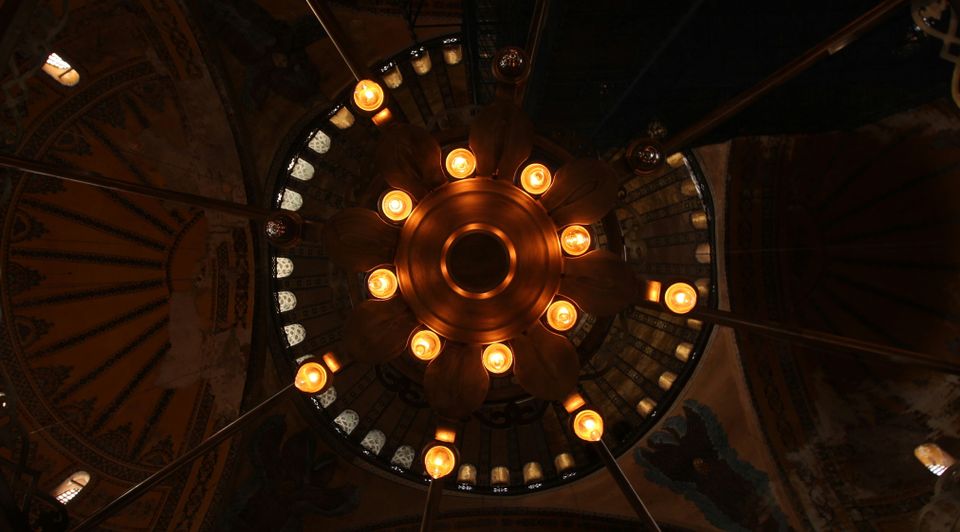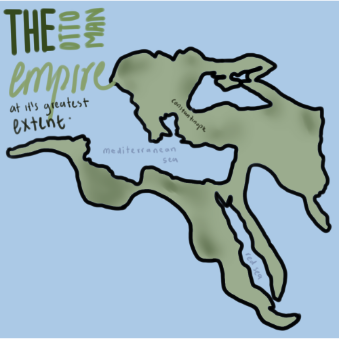The Ottoman Empire

The Ottoman Empire was one of the biggest and longest lasting empires in history, capturing most of the mediterranean sea and having only one civil war within the 600 years they ruled. It all started with a man named Osman in the 13th century, after a downfall, it rose again and flourished for a few more decades before crumbling down because of a signed treaty with Germany in World War 1.
The Ottoman Empire was founded at the end of the 13th century in northwestern Anatolia in the town of Söğüt. According to their descendants, the empire started with a man named Osman.
As the Seljuk Sultanate of Rum declined in the 13th century, Anatolia was divided into a patchwork of Turkish principalities, which were known as beyliks, and Osman had established a very small beylik on the frontier of the Byzantine empire. Within a few decades, this small beylik was transformed into a transcontinental empire, known as the Ottoman empire.
It is said that Osman had a dream about a tree growing out of him, and it covered the whole world. Later on, Osman extended the control of his beylik by conquering Byzantine towns along the Sakarya River, fighting along certain sides when needed, and against them when the time was right. It is not clear how the Ottomans came to dominate their neighbours, due to the fact that the Ottomans did not do a lot of writing until they stopped moving their capital for 20 years and finally settled down. Not long after, Osman, I had passed away. His son Orhan established a military organization geared towards quick territorial expansion. The Ottoman’s first major expansions were in the Balkans. Orhan had captured the northwestern Anatolian city of Bursa in 1326, thus making it the new capital of the Ottoman state and replacing it with Byzantine control in the region. The Ottomans soon took over Kosovo in 1289 and ended Serbian power in the region, thus the Ottomans had expanded into Europe. As the Turks expanded into the Balkans, the conquest of Constantinople became a critical objective for the Ottomans, but due to the powerful defence on Constantinople, they had failed.

By the end of the 14th century, the Ottomans had conquered most of the Anatolian Beyliks. In the first half of the 15th century, as Sultan Bayezid I focused on western expansion, Turkic Mongol leader, Timur invaded Ottoman Anatolia from the east. Timur had defeated the Ottoman forces and had taken Sultan Bayezid I as a prisoner, which threw the whole empire into a clutter. Ensuing civil war is the only civil war in their 600 year long history. Sultan Murad II had taken matters into his own hands, he had recovered lost Ottoman territories, but he failed to complete his biggest goal, capturing the Byzantine capital, Constantinople.
His son, Sultan Mehmed II vowed to succeed where his father had failed. In order to prepare for the attack on Constantinople, hired a Hungarian Engineer to forge the largest cannon in the world, used Serbian miners to dig tunnels under the walls of the city, and ordered all his ships to be carried overland - attacking the city in an unexpected way. He laid siege to the city and in the spring of 1452, Constantinople fell to the ottomans. It became the Ottoman capital known by its common Greek name “Istanbul”, meaning “to the city”.
After Mehmed II conquered Constantinople, it became more developed under Ottoman rule. They entered a golden age of economic growth, territorial acquisition, art and architecture. The Ottomans would continue to expand, cementing their political influence and lucrative trade routes, but as all things would come to an end, so did the Ottoman Empire. Some say it would have lasted more than 600 years if not for its slow and long decline. Before WW1, the Ottoman Empire had signed a secret treaty with Germany, and after fighting on the side of Germany in WW1, they suffered defeat. The empire came tumbling down and came to an end in 1922.
One of the capital city's great buildings was Hagia Sophia. It has been a church, a mosque, a museum, and is still being used for different forms of art and artefacts.
The Ottoman Empire was a source of great regional stability and security, as well as important achievements in the arts, science, religion and culture. So naturally, it is important in the story of humanity.
References
https://www.youtube.com/watch?v=SZ8UWobHA3M
https://www.youtube.com/watch?v=SZ8UWobHA3M
https://en.wikipedia.org/wiki/Ottoman_Empire#:~:text=The%20Ottoman%20Empire%20
Author biography
Fathimath Myraz Miraz, is a young learner who currently attends Professor Ugail’s prestigious Leaders of Tomorrow programme by Ugail Foundation. She has a wide range of interests. Some of the things that spark her interests are poetry, art and literature, psychology, and space. Her Myers-Briggs Personality Type is INFJ. She enjoys learning new things, including languages, enhancing her drawing and writing skills.

Cite this article as:
Fathimath Myraz Miraz, The Ottoman Empire, theCircle Composition, Volume 1, (2021). https://thecirclecomposition.org/the-ottoman-empire/
